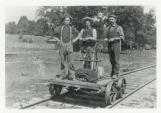19
Another early settler was Lieut. William Johnson (later Captain). Johnson arrived in 1819, also by foot, and, having lost a cow, followed a Native trail to search for it. This is how he came upon an excellent site for a mill. It was this site which in 1823 became the little town of Pefferlaw.
Johnson left a diary from 1832 to 1850. In it he records daily activities at his farm. Business at York required him and his workmen to travel by horseback, and occasionally with a cart, though more than one of his workers travelled by foot to Newmarket, Holland Landing, Sharon (Hope), and York.
Thomas Mossington, though not a Navy man, was a civilian employee of the British Navy Office. He travelled to Canada for business as a timber agent. In 1830 he purchased land in Georgina Twp. He wrote to a friend about the journey, asserting that numerous coaches, steamers, and stops in taverns made this an impressive network for communication.
20
Steamer Islay at Jackson's Point.
1900
Jackson's Point, Ontario, Canada
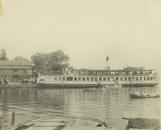
21
On Sunday September 30 1832, William Johnson noted in his diary, "Heard that steamer arrived at Jackson's Point." Ever the efficient Navy man, Johnson's diaries are less than enthusiastic. But what a site this must have been! Even though the Navy men along the shore knew it was coming (most of them were shareholders in the venture), it must have been a spectacular sight.
The first steamer stopped at the homes of its shareholders. One of these shareholders was John Mills Jackson, for which Jackson's Point is named. Here he had a warehouse and store for early residents to receive their supplies and mail.
22
Steamer Enterprise next to the train at Jackson's Point.
1900
Jackson's Point, Ontario, Canada
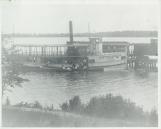
23
Steamer Enterprise at Jackson's Point.
1900
Jackson's Point, Ontario, Canada
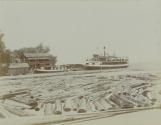
24
Recently a marine railway was discovered in Lake Simcoe. It was here that steamers would be hoisted onto land for storage and repairs. This is where the famous Steamer Enterprise, immortalized as the 'Mariposa Belle' by Stephen Leacock, was dry docked and her machinery removed before being scuttled in deep water. In later years, the wharf at Jackson's Point would become one of the Lake Simcoe's busiest ports for lake excursions by tourists aboard steamers.
25
First train to Sutton.
1877
Sutton, Ontario, Canada
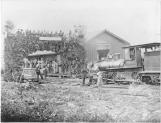
26
In 1877 the first train rolled into Sutton. The Lake Simcoe Junction Railway was a branch of the Toronto & Nipissing Railway. Service would later be provided by the Grand Trunk and the Canadian National Railways.
27
Work and play at the railway wharf, Jackson's Point.
1900
Jackson's Point, Ontario, Canada
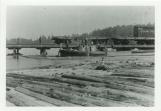
28
The train arrived with much fanfare; the residents knew it would change their town. There was already the Spring Water Ice Company, cutting ice from Lake Simcoe and transporting it to Toronto by horse and wagon. With the coming of the train the industry exploded. Spring Water Ice Company became Lake Simcoe Ice Company. Other companies entered the area, huge warehouses were built in Jackson's Point. The train, which was extended to Jackson's Point, went onto a railway dock. Alongside this, ice stored in the warehouses was loaded onto freight trains and shipped out.
29
Railway workers in Georgina Twp.
1920
Georgina Township, Ontario, Canada

30
Grand Trunk Railway workers in Jackson's Point.
1898
Jackson's Point, Ontario, Canada
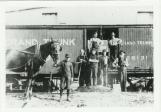
31
Workmen at a Grand Trunk freight car.
1909
Jackson's Point, Ontario, Canada
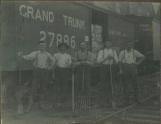
32
Railway workers.
1898
Jackson's Point, Ontario, Canada
